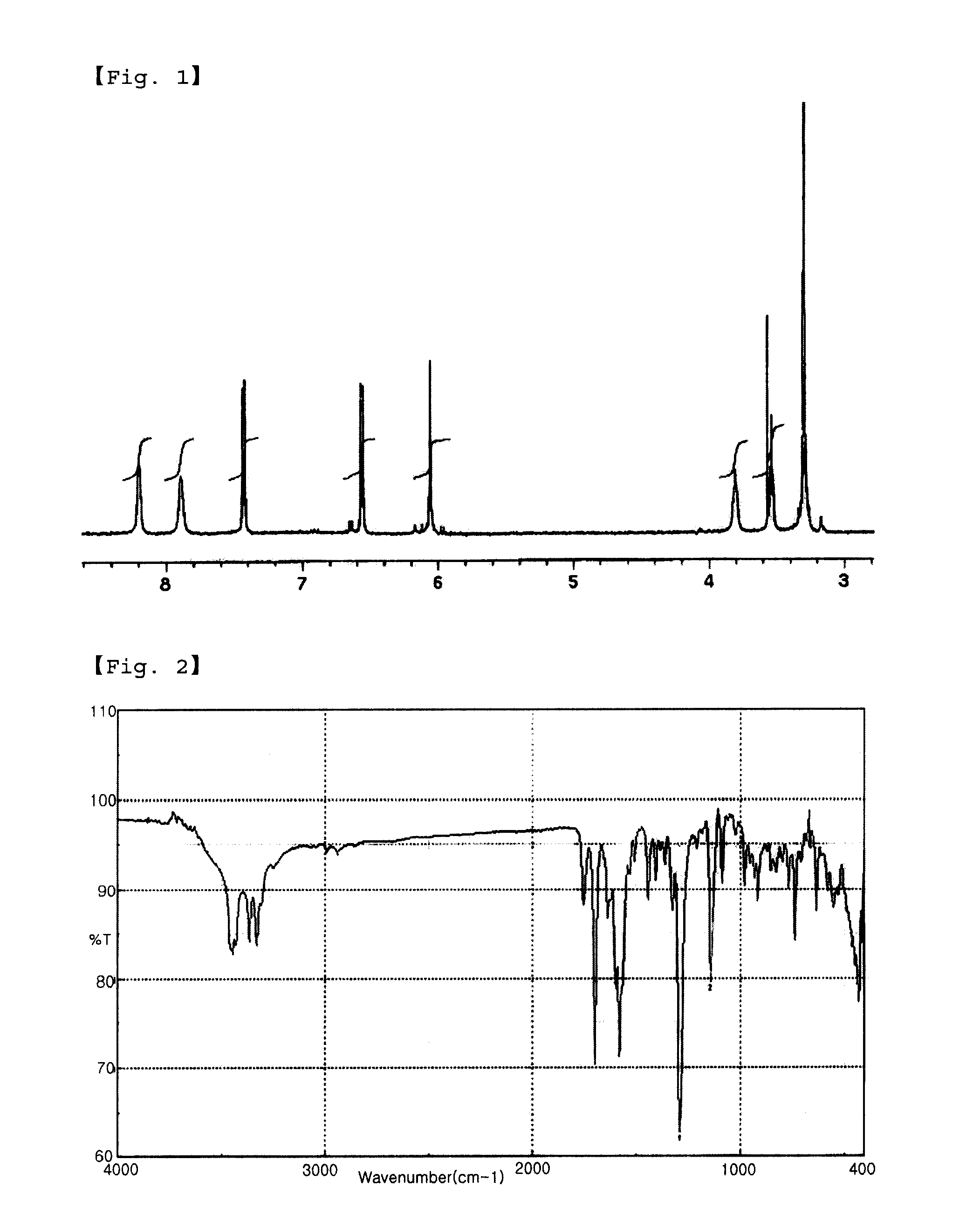Beta-sulfone imides and preparation thereof
a technology of sulfonimide and imides, which is applied in the field of new sulfonimide compounds, can solve the problems of difficult preparation of -sulfonimide by the afore-mentioned process, inability to synthesize polyimides, and failure to develop various compounds
- Summary
- Abstract
- Description
- Claims
- Application Information
AI Technical Summary
Benefits of technology
Problems solved by technology
Method used
Image
Examples
example 2
Preparation of 1-[2-(4-amino-benzenesulfonyl)-ethyl]-pyrrolidine-2,5-dione
[0046]In a 100 mL round bottom flask, a mixture of 1.15 g of succinimide, 2 g of 4-ethenesulfonylphenylamine and 30 g of 1,4-dioxane was heated to 60-70° C. and stirred. To the reaction solution was added 0.75 g of 40% aqueous tetrabutylammonium hydroxide solution 3 times over a 1-hour period. Subsequently, the mixture was stirred at 60-70° C. for 2 more hours. When the solution turned into a white suspension, stirring was stopped and the reaction solution was cooled to room temperature and precipitated and dispersed in 100 mL of methanol. The resultant precipitate was filtered, redispersed in 100 mL of clean water, filtered again and washed to remove salt. Then, the product was redispersed in 500 mL of methanol, filtered and dried to obtain 2.2 g of 1-[2-(4-amino-benzenesulfonyl)-ethyl]-pyrrolidine-2,5-dione (yield=70%).
[0047]IR (KBr): vmax=1294.9 cm−1, 1138.7 cm−1 (—SO2—)
[0048]1H-NMR (DMSO-d6) δ (ppm): 7.4 (...
example 3
Preparation of 1,4-diaminoanthraquinone-(N-vinylsulfonylethyl)-2,3-dicarboxylmide
[0050]In a 1 L round bottom flask, a mixture of 50 g of 1,4-diaminoanthraquinone-2,3-dicarboxylmide, 21 g of divinylsulfone and 400 g of 1,4-dioxane was heated to 40-50° C. and stirred. To the reaction solution was added 11 g of 40% aqueous tetrabutylammonium hydroxide solution 3 times over a 1-hour period. Subsequently, the mixture was stirred at 40-50° C. for 5 more hours. After stopping stirring, the reaction solution was cooled to room temperature and precipitated and dispersed in 1 L of methanol. The resultant precipitate was filtered, redispersed in 100 mL of clean water, filtered again and washed to remove salt. Then, the product was redispersed in 1 L of methanol, filtered and dried to obtain 66 g of 1,4-diaminoanthraquinone-(N-vinylsulfonylethyl)-2,3-dicarboxylmide (yield=95%).
[0051]IR (KBr): vmax=1290.1 cm−1, 1132.9 cm−1 (—SO2—)
[0052]1H-NMR (DMSO-d6) δ (ppm): 8.2 (2H, d, ArH), 7.0 (1H, m, —CH═...
example 4
Preparation of bis(1,4-diaminoanthraquinone-(N-ethyl)-2,3-dicarboxylmide)sulfone
[0054]In a 100 mL round bottom flask, a mixture of 2 g of 1,4-diaminoanthraquinone-2,3-dicarboxylmide, 0.39 g of divinylsulfone and 15 g of 1,4-dioxane was heated to 40-50° C. and stirred. To the reaction solution was added 0.43 g of 40% aqueous tetrabutylammonium hydroxide solution. Subsequently, the mixture was stirred at 50-60° C. for 4 more hours. After stopping stirring, the reaction solution was cooled to room temperature and precipitated and dispersed in 100 mL of methanol. The resultant precipitate was filtered, redispersed in 100 mL of clean water, filtered again and washed to remove salt. Then, the product was redispersed in 50 mL of methanol, filtered and dried to obtain 2.1 g of bis(1,4-diaminoanthraquinone-(N-ethyl)-2,3-dicarboxylmide)sulfone (yield=87%).
[0055]IR (KBr): vmax=1290.1 cm−1, 1125.3 cm−1 (—SO2—).
[0056]
PUM
| Property | Measurement | Unit |
|---|---|---|
| temperature | aaaaa | aaaaa |
| temperature | aaaaa | aaaaa |
| pressure | aaaaa | aaaaa |
Abstract
Description
Claims
Application Information
 Login to View More
Login to View More - R&D
- Intellectual Property
- Life Sciences
- Materials
- Tech Scout
- Unparalleled Data Quality
- Higher Quality Content
- 60% Fewer Hallucinations
Browse by: Latest US Patents, China's latest patents, Technical Efficacy Thesaurus, Application Domain, Technology Topic, Popular Technical Reports.
© 2025 PatSnap. All rights reserved.Legal|Privacy policy|Modern Slavery Act Transparency Statement|Sitemap|About US| Contact US: help@patsnap.com



